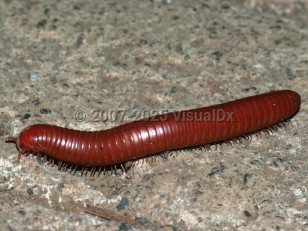Millipede dermatitis in Adult
Synopsis

Millipedes have no venom or apparatus for injecting venom (no fangs, biting mouthparts, or stingers). Rather, their means of defense is to squirt, up to 80 cm, a caustic liquid from pores along their sides. The liquid is composed of a variety of chemicals, such as hydrogen cyanide, phenol, and organic acids, which can induce a contact dermatitis in humans.
Skin exposure to millipede secretions can cause a burning sensation, inflammation, and a tanning discoloration of the skin that may subsequently blister and exfoliate, resulting in pigmentation and scarring. Ocular exposure can cause immediate pain and tearing and may lead to chemosis, blepharospasm, periorbital edema, conjunctivitis, keratitis, and corneal ulceration. Blindness is reported in the literature but is not well substantiated. No human fatalities have been associated with millipede secretions.
Codes
T63.411A – Toxic effect of venom of centipedes and venomous millipedes, accidental, initial encounter
SNOMEDCT:
403154004 – Millipede burn
Look For
Subscription Required
Diagnostic Pearls
Subscription Required
Differential Diagnosis & Pitfalls

Subscription Required
Best Tests
Subscription Required
Management Pearls
Subscription Required
Therapy
Subscription Required
References
Subscription Required

